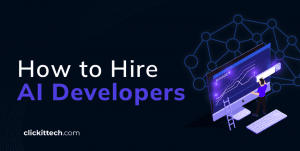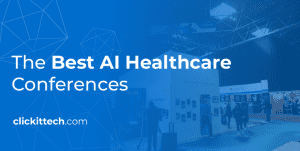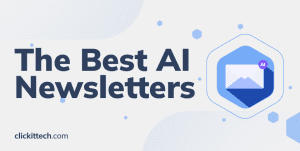IoT Healthcare solutions promise to deliver devices where healthcare isn’t confined to the walls of a hospital, but instead, it integrates with our daily lives, empowering patients and healthcare professionals through IoT applications and devices.
The cutting-edge synergy of healthcare and technology has already woven itself into numerous industries. And, unlike what you might think, IoT Healthcare goes far beyond smart devices and wearables.
In this blog, we will go through the realms of IoT Healthcare. We’ll explore its diverse IoT applications in healthcare and showcase ten real-life examples of IoT Healthcare applications driving us toward a brighter, healthier future.
Let’s get going.
Table of contents
- What does IoT Healthcare Mean?
- IoT Healthcare’s Journey of Innovation and Transformation
- Exploring the Benefits of IoT Healthcare
- Addressing Challenges in IoT Healthcare
- Types of IoT Healthcare Solutions
- 10 Real-Life Examples of IoT Healthcare Devices
- Envisioning a Connected Future with IoT Healthcare
- Partnering for Success: ClickIT is your Trusted Healthcare Development Partner
- Conclusion of Internet of Things Healthcare
- IoT Healthcare FAQs
What does IoT Healthcare Mean?
At its core, IoT Healthcare is an interconnected web of smart healthcare devices, sensors, and applications that monitor and revolutionize our approach to healthcare. These IoT Healthcare devices have chips, sensors, and related technologies to collect and transmit vital signs and other relevant health information.
The data collected by IoT Healthcare devices empower physicians to make informed decisions. Moreover, they enhance the efficiency of hospital equipment and staff, ensuring timely interventions and personalized treatments.
In other words, IoMT’s magic lies in integrating medical devices with healthcare information technology systems through online computer networks.
By leveraging Wi-Fi and communication technologies, IoT Healthcare devices create a connected infrastructure that transcends traditional clinical settings’ boundaries. Said devices establishing machine-to-machine communication form the very foundation of IoT Healthcare.
Now, let’s set something straight; the impact of IoMT goes beyond medical consultations. It empowers patients to take charge of their health, fostering a sense of autonomy and well-being. Connected instruments and IoT software applications work to streamline patient care and enhance the overall healthcare experience.

IoT Healthcare’s Solutions Journey of Innovation and Transformation
The Internet of Things concept traces back to the 1800s with the arrival of electric telegraph systems. Nonetheless, it wasn’t until the 21st century that IoT became a global phenomenon. Today, there are over 50 billion IoT-enabled devices worldwide. Its reach extends to numerous industries, including, obviously, healthcare.
It took a while, but now healthcare professionals grasp the immense potential and benefits that IoT Healthcare Devices offer across several field verticals.
Through IoT-enabled devices, physicians and nurses gain access to real-time patient data. Leading to informed medical decisions, reducing human interaction, and minimizing the potential for error.
Nevertheless, it was the outbreak of the COVID-19 pandemic that catalyzed the rapid proliferation of IoT in the healthcare market. As the risk of viral infection during hospital visits surged, healthcare systems turned to IoT solutions to ensure patient safety. The pandemic ushered in a new era of healthcare practices, prompting hospitals to increasingly adopt IoT healthcare devices for diagnosis, treatment, and monitoring.
What are the Benefits of IoT Healthcare Solutions?
We’ll say it again: IoT’s transformative power redefines the essence of patient care and healthcare operations. Embracing IoT Healthcare Devices and solutions opens up a world of possibilities that extend its benefits to all stakeholders involved.
For example, IoT Healthcare paves the way for patients and their families to achieve heightened engagement and satisfaction. Interacting with healthcare professionals empowers patients to participate in their well-being actively. It also fosters a sense of control and autonomy.
In addition, this type of monitoring transcends geographical barriers, reducing hospital stays and ultimately leading to cost savings and improved treatment outcomes.
Let’s take a closer look at the most significant benefits of IoT healthcare solutions.
- Logistics
- Cost Control
- Better Patient experience
- Increased Accuracy
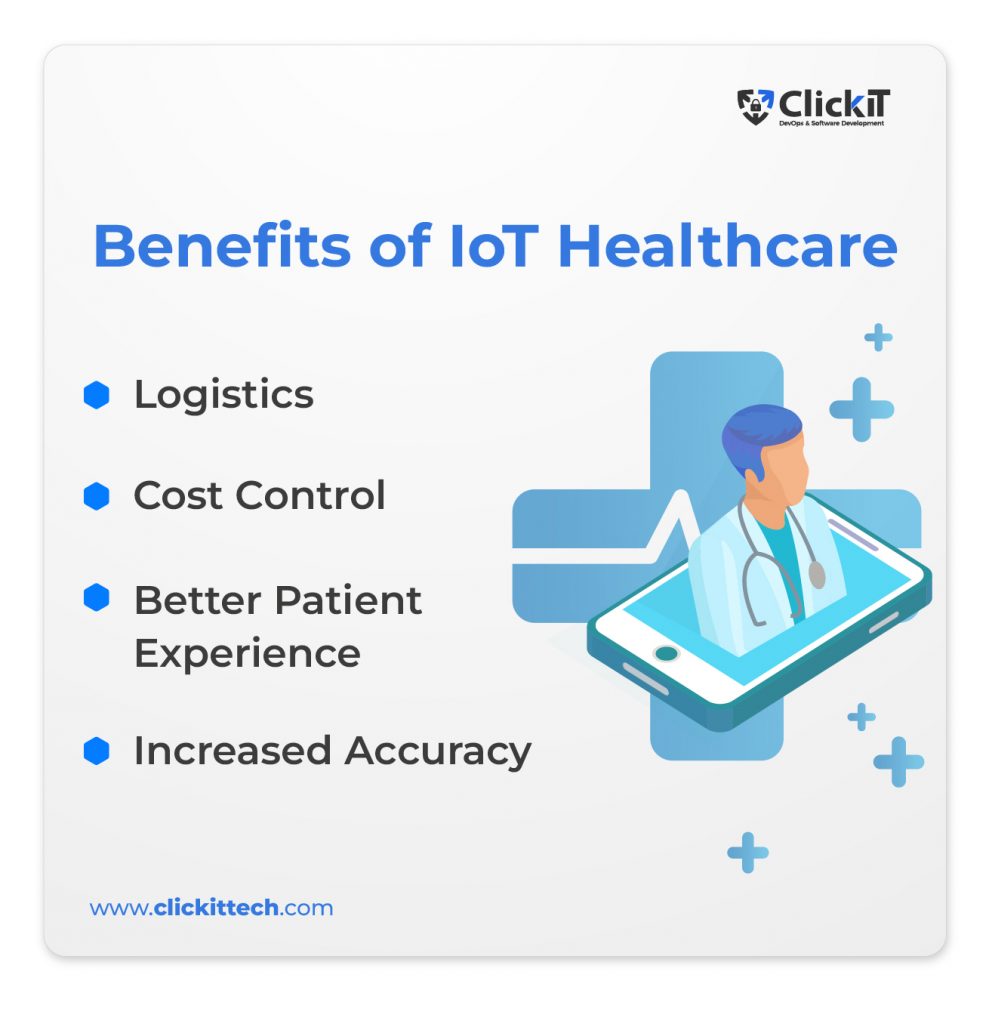
Logistics
One of the key advantages of IoT Healthcare devices lies in their ability to monitor crucial equipment within medical facilities. These intelligent devices act as vigilant guardians, cautiously observing the health and functionality of the equipment.
In the event of any maintenance issues or anomalies, IoMT devices promptly send alerts, enabling timely interventions and preventing potential breakdowns that could disrupt medical procedures.
Additionally, the application of Healthcare Devices as patient and medication trackers marks a significant stride toward precision and safety.
Equipping patients and medications with IoT-enabled tags allows healthcare facilities to gain real-time insights into their locations and movements throughout the medical campus. This substantially reduces mix-ups and mistakes, ensuring patients receive adequate care at the right time.
Cost Control
Cost control stands as a critical factor shaping the accessibility and affordability of medical services. Consequently, RPM (Remote Patient Monitoring) accounts for a big part of IoT Healthcare contribution. Throught the continuous collection and analysis of vital data from IoMT devices, professionals stay informed about patient’s well-being, even from a distance.
This proactive approach significantly reduces the need for unnecessary visits to doctors and hospital stays. Besides, it optimizes resource utilization and patients’ care journey.
Faster processing of health data is another aspect that accentuates cost control in healthcare. With IoT-enabled devices and advanced data analytics, healthcare providers can efficiently manage and interpret large volumes of patient information. They can redirect their resources to areas requiring immediate attention, ensuring each patient receives the best possible attention.
Better Patient Experience
Embracing IoT Healthcare applications and solutions brings forth a transformative wave that enhances patient experiences like never before. IoMT enables the use of innovative technologies that empower patient self-service. This newfound autonomy minimizes the need for frequent in-person visits, fostering a sense of empowerment and control.
Additionally, virtual consultations and telehealth services allow patients to consult with their doctors from the comfort of their homes, eliminating the constraints of distance and travel. Convenience is always a must for a memorable patient experience!
Increase Accuracy
IoT Healthcare provides medical clinicians with abundant data that yields more accurate insights into patients’ health conditions. Devices, such as blood pressure monitors, continuously collect and record data that provide medical clinicians with a holistic understanding of a patient’s health.
The interconnected nature of IoT Healthcare also facilitates seamless data sharing among various healthcare professionals involved in a specific case. This collaborative approach enables a multidisciplinary team to develop comprehensive treatment strategies collectively.
Addressing Challenges in IoT Healthcare
With every groundbreaking innovation, unique challenges requiring careful consideration and proactive solutions emerge. The case of IoT Healthcare is no exception.
Data Classification
Traditionally, medical data was well-defined, comprising explicit health-related information collected directly from patients during clinical interactions. Nowadays, with the emergence of AI-driven applications, a new aspect of data has come into play.
Data derived from non-health-related information, such as consumer behavior and other seemingly unrelated traces, have transformed into valuable medical insights professionals use to identify patterns and perform timely interventions. All this information has made defining and classifying medical data increasingly complex.
Security Concerns
Transmitting medical data via IoT Healthcare Devices exposes providers to various cybersecurity threats, ranging from data breaches to fraudulent activities.
The consequences of security breaches in IoT Healthcare are far-reaching, with providers facing severe compliance penalties and fines. That’s exactly why protecting patient privacy and adhering to data regulations are essential for a strong reputation and ensuring continuity of care.
Meet the best security standards with HIPAA Compliance
Ethical Considerations in IoT Healthcare
The nature of IoT Healthcare also raises questions about data ownership and control. Healthcare institutions must balance data utilization for patient well-being and safeguarding patient privacy and data rights. Respecting data ownership ensures that patients retain control over how others use and share their health data.
Furthermore, transparent communication and informed consent protocols are essential to uphold patient rights and ensure they have agency over their health information.
Types of IoT Healthcare Solutions
In this section, we’ll dive deeper into the different types of IoT Healthcare Solutions, exploring their applications and value in the healthcare ecosystem.
From wearables that empower patients to monitor their health actively to in-hospital devices that streamline medical workflows, the possibilities of IoT in healthcare are as vast as the benefits they offer.
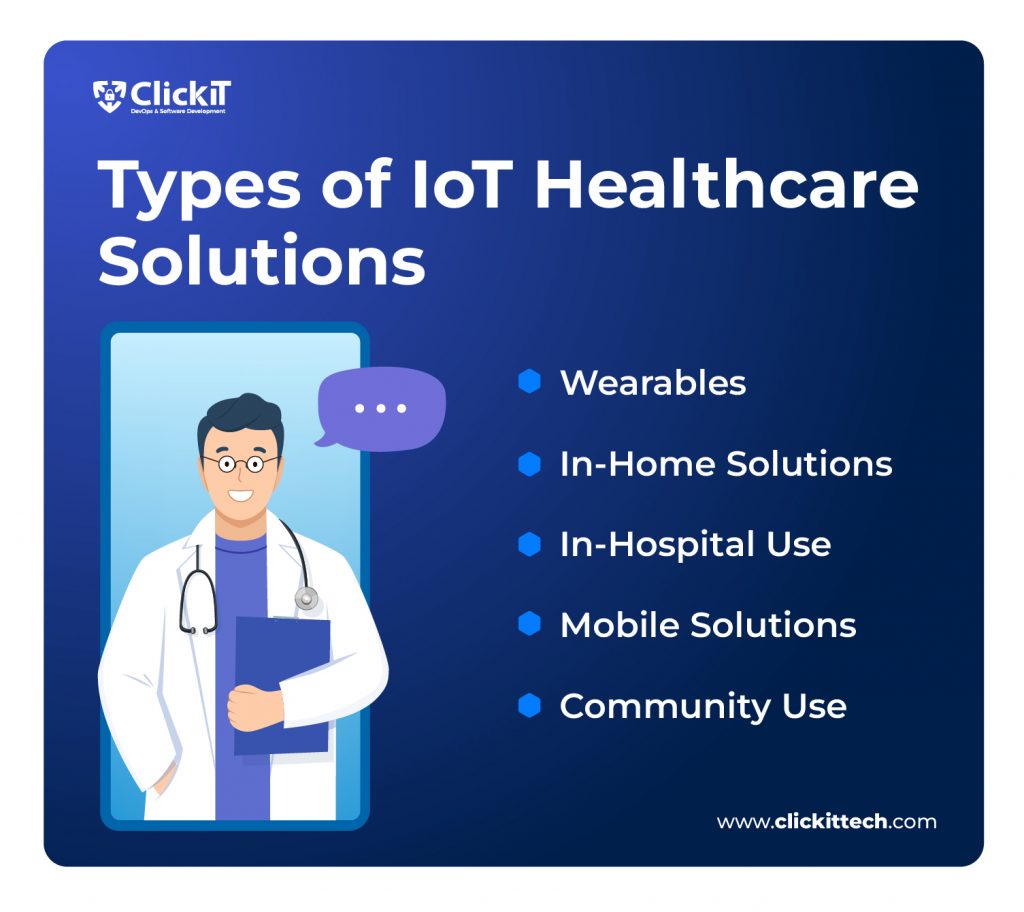
IoT healthcare solution: Wearables
The value of wearables in IoT Healthcare rests in their ability to collect real-time health data and their potential to revolutionize patient engagement and medical decision-making.
These devices connect to a person’s body, capturing vital medical information, and come in two main categories: consumer-grade and medical-grade devices. Consumer-grade wearables, such as smartwatches, bring health data to users’ fingertips. They provide insights into heart rate, blood pressure, and other health metrics.
On the other hand, medical-grade wearables are designed for use under the guidance and supervision of healthcare professionals. They serve diverse medical purposes, from neuromodulation devices that manipulate the nervous system to ingestible sensors that gather information inside the patient’s body.
IoT healthcare solution: In-Home
This IoT healthcare solution is thoughtful. The design of these devices allows them to integrate into patients’ daily lives, transforming homes into personalized and connected care hubs.
In-home solutions encompass a diverse range of IoT Healthcare Devices strategically placed in or around a patient’s home. One prime example is personal emergency response systems (PERS), which feature devices equipped within the home to detect and respond swiftly to emergencies.
IoT healthcare solution: In-Hospital Use
A prominent application of IoT examples in hospitals lies in patient care, where IoT Healthcare Devices support healthcare professionals in delivering accurate care. Infusion pumps, for instance, connect to analytics dashboards, allowing healthcare providers to monitor patients’ medication closely.
The use of IoT Healthcare Devices also extends beyond patient care to asset and inventory management. Hospitals employ tags on medical equipment and supplies, which update hospital staff on the quantities in stock and their precise locations. This real-time visibility optimizes inventory control, reducing waste and ensuring that critical supplies are readily available when needed.
IoT healthcare solution: Mobile
Mobile devices, such as smartphones and tablets, have become indispensable tools in healthcare, offering connectivity and access to medical information.
IoMT devices use near-field communication and radio frequency identification tags, enabling devices to communicate and share information with other IT systems. This connectivity empowers patients and medical personnel with unprecedented control and accessibility to essential health data.
Mobile solutions offer a new level of control for patients managing chronic conditions. Networked glucose monitors, for instance, can be controlled and monitored directly from patients’ mobile phones. This gives them real-time insights into their blood sugar levels and health trends.
IoT healthcare solution: Community Use
These ingenious solutions provide individuals in remote regions and underserved communities with access to essential healthcare services and support.
An example of community use in IoT Healthcare is the deployment of point-of-care kiosks. These kiosk solutions serve as vital healthcare stations, dispensing medical supplies and facilitating connections between patients and caregivers.
10 Real-Life Examples of IoT Healthcare Devices
As we have seen, the uses and benefits of IoT in healthcare know no limits. They are here to improve medical delivery, and the following real-life examples will show us specific ways how they’re doing it. Let’s head straight on.

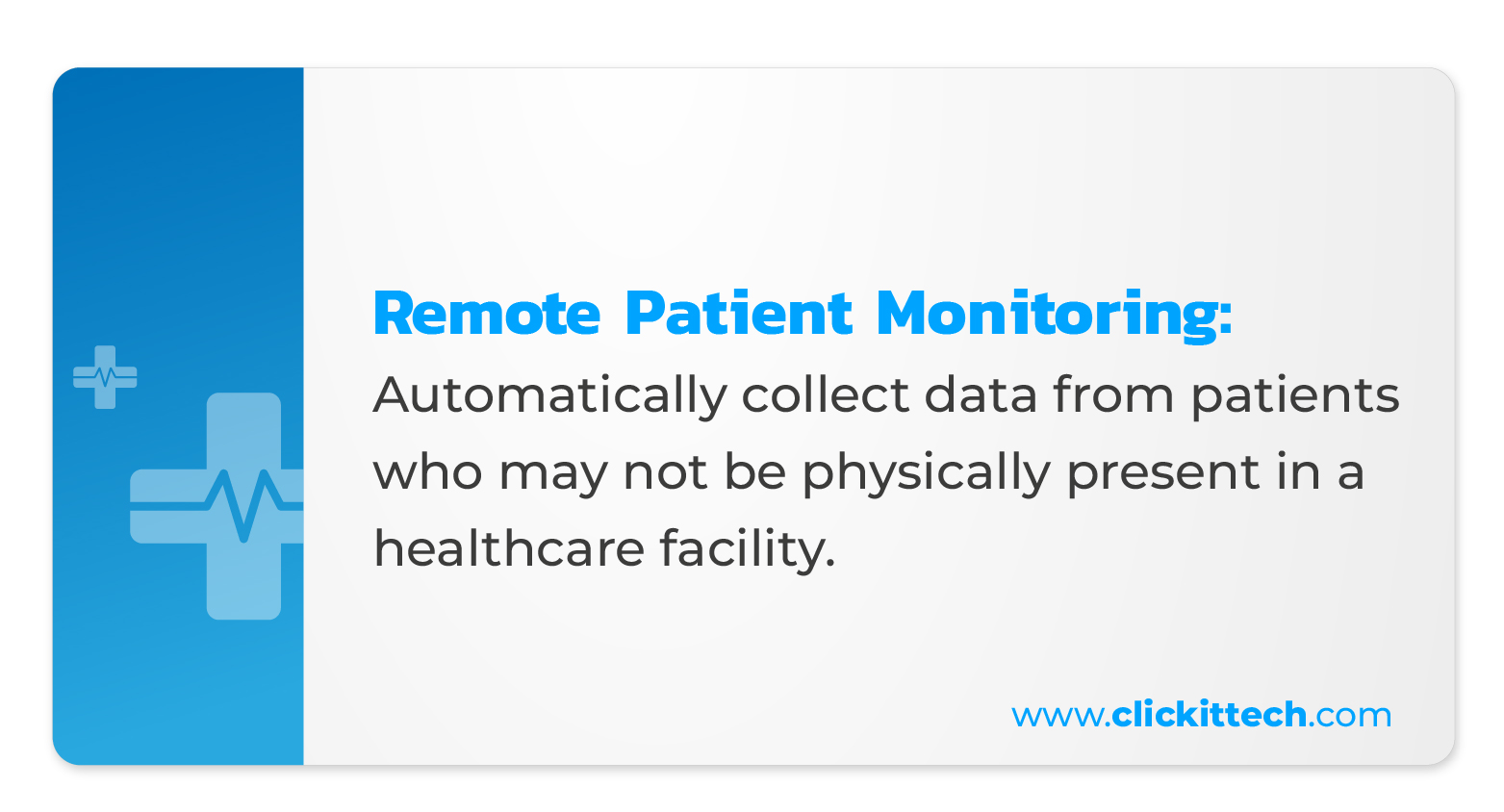
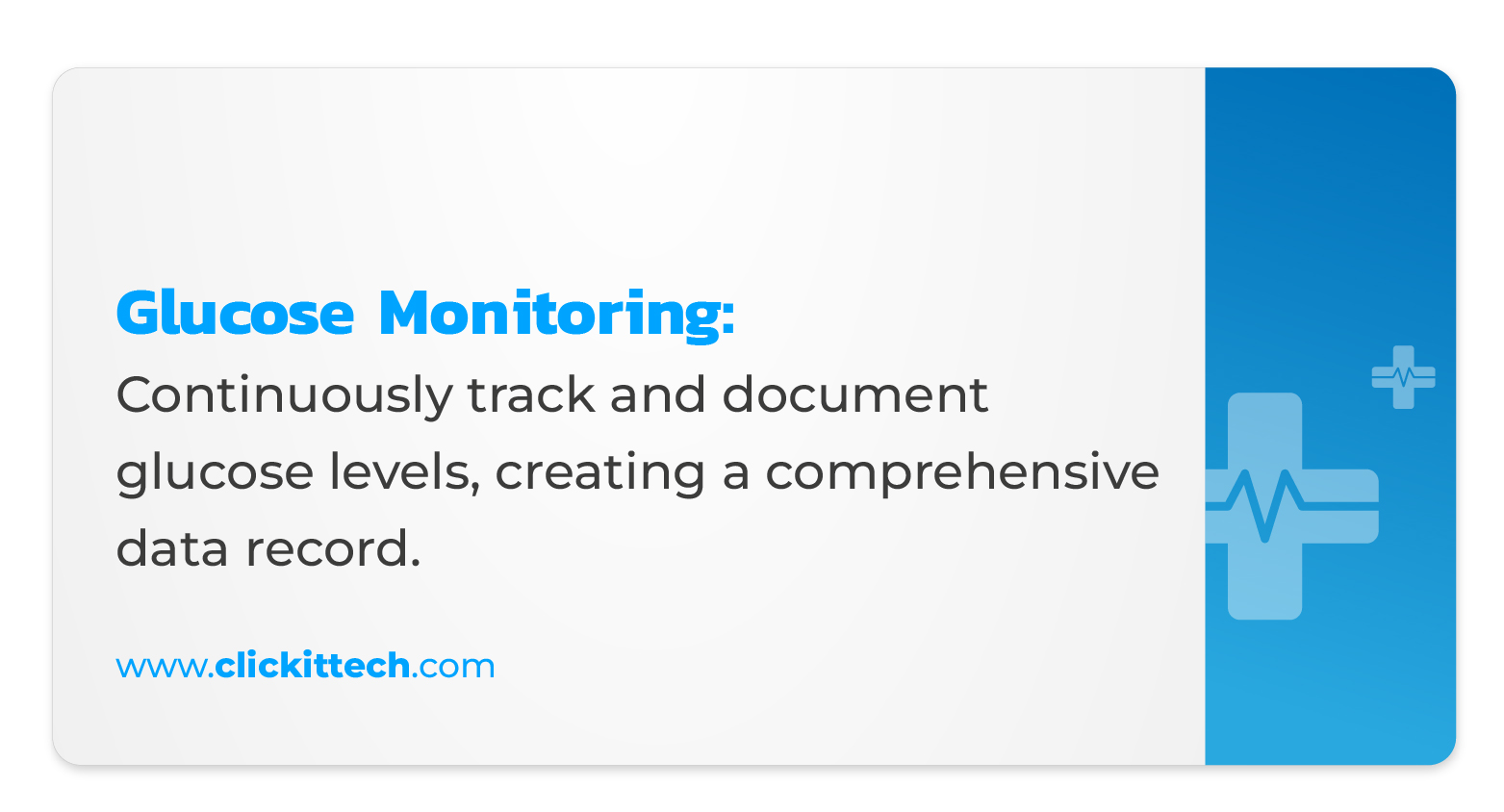

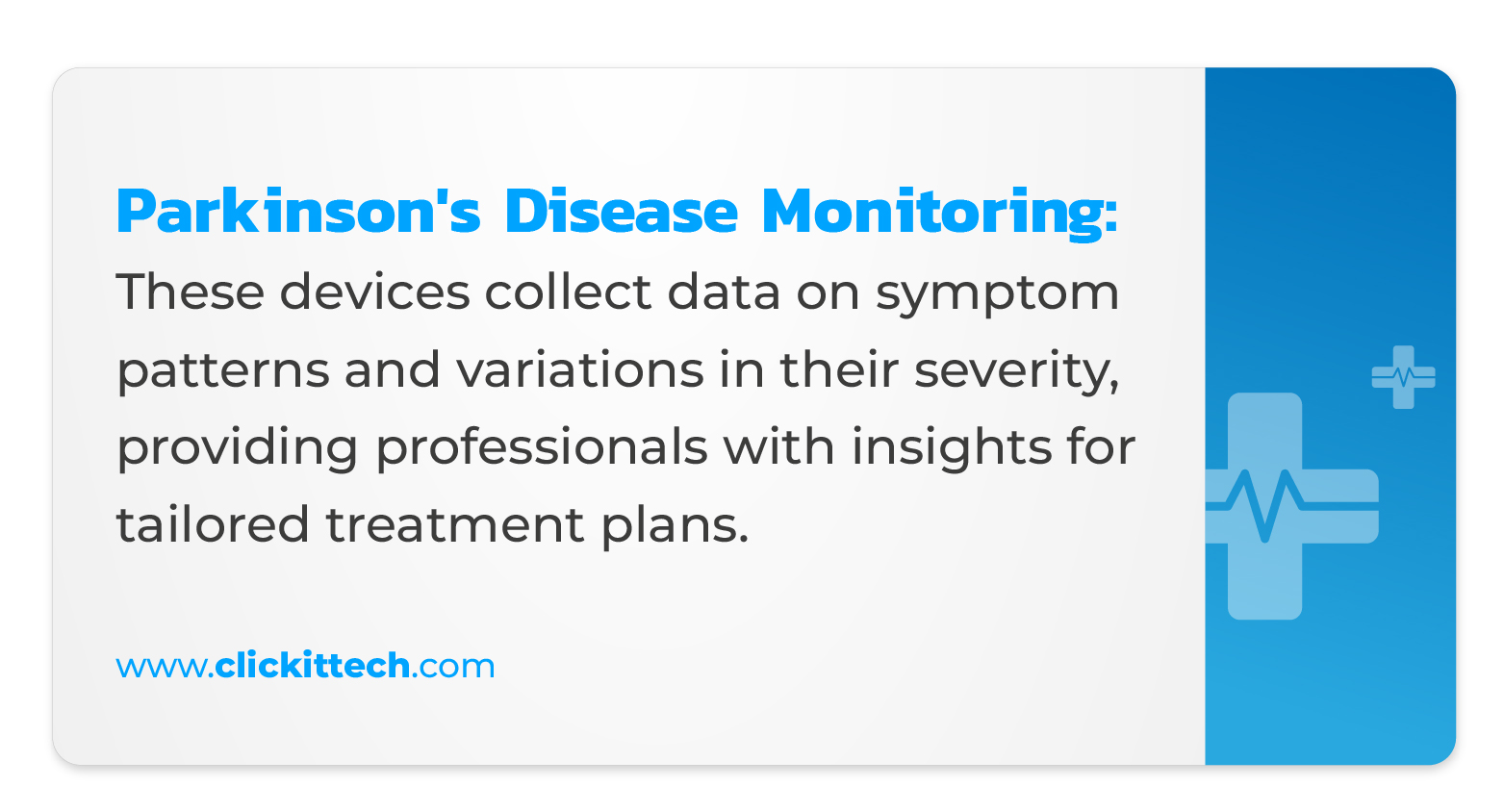
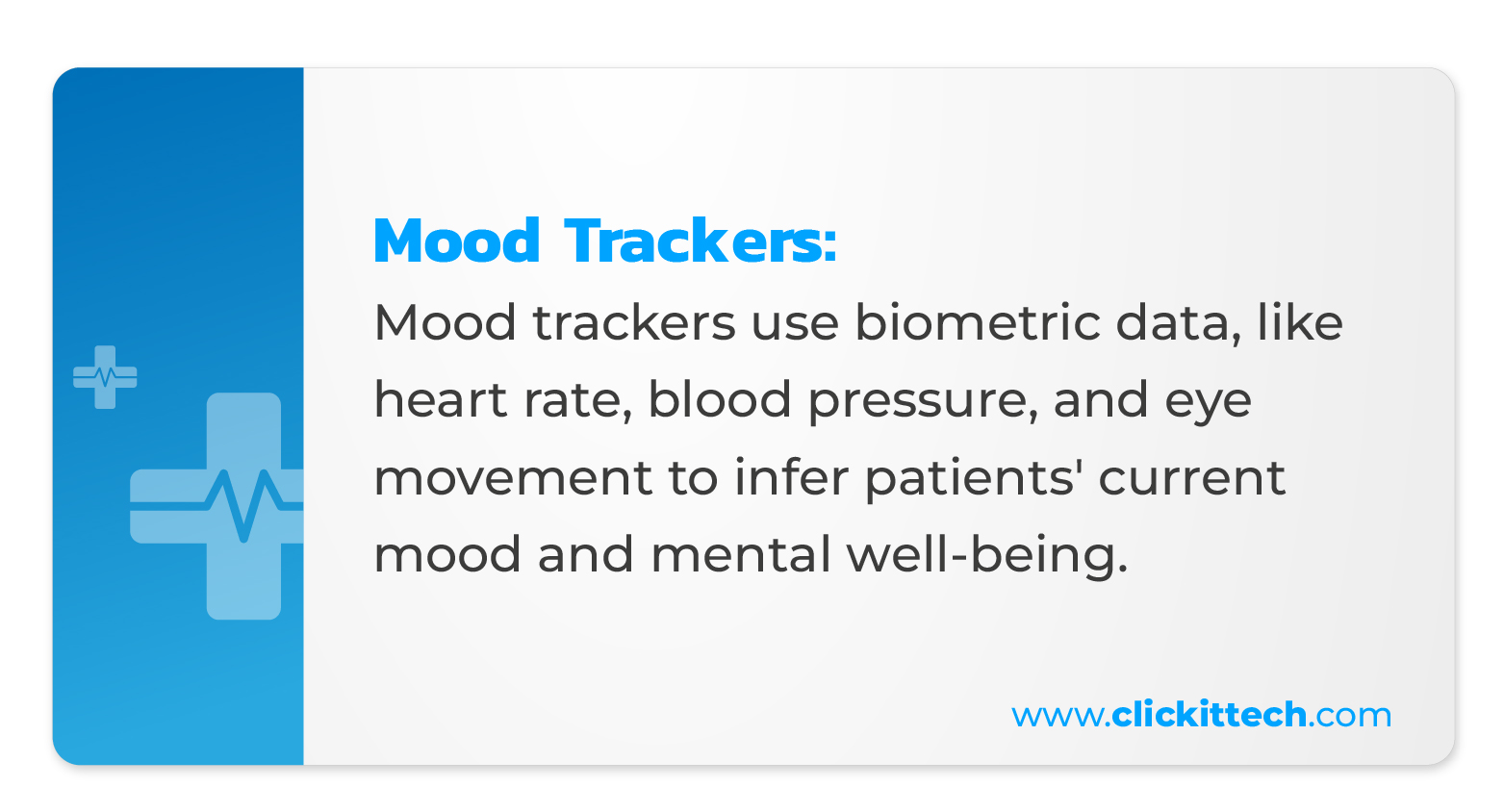
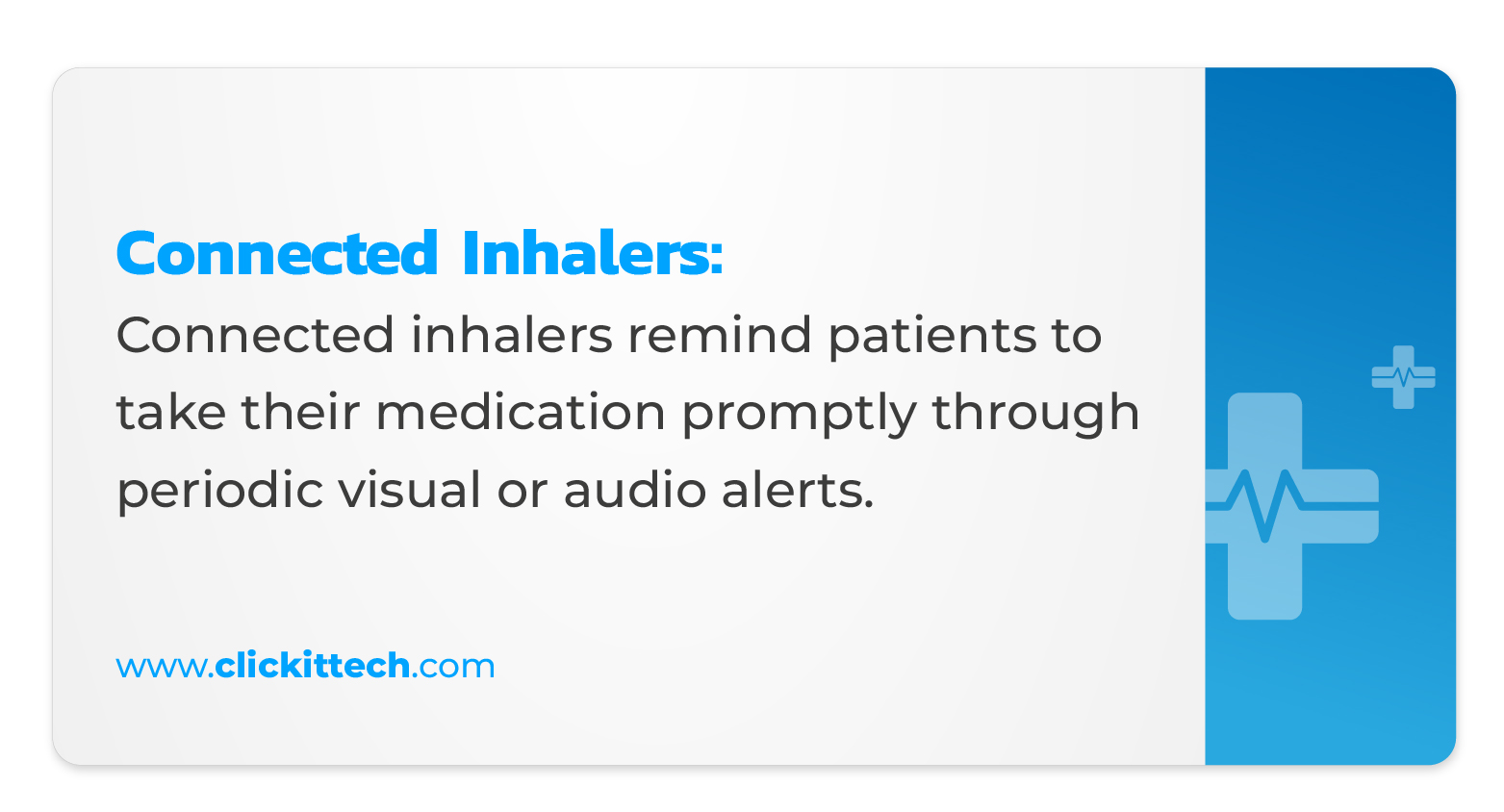
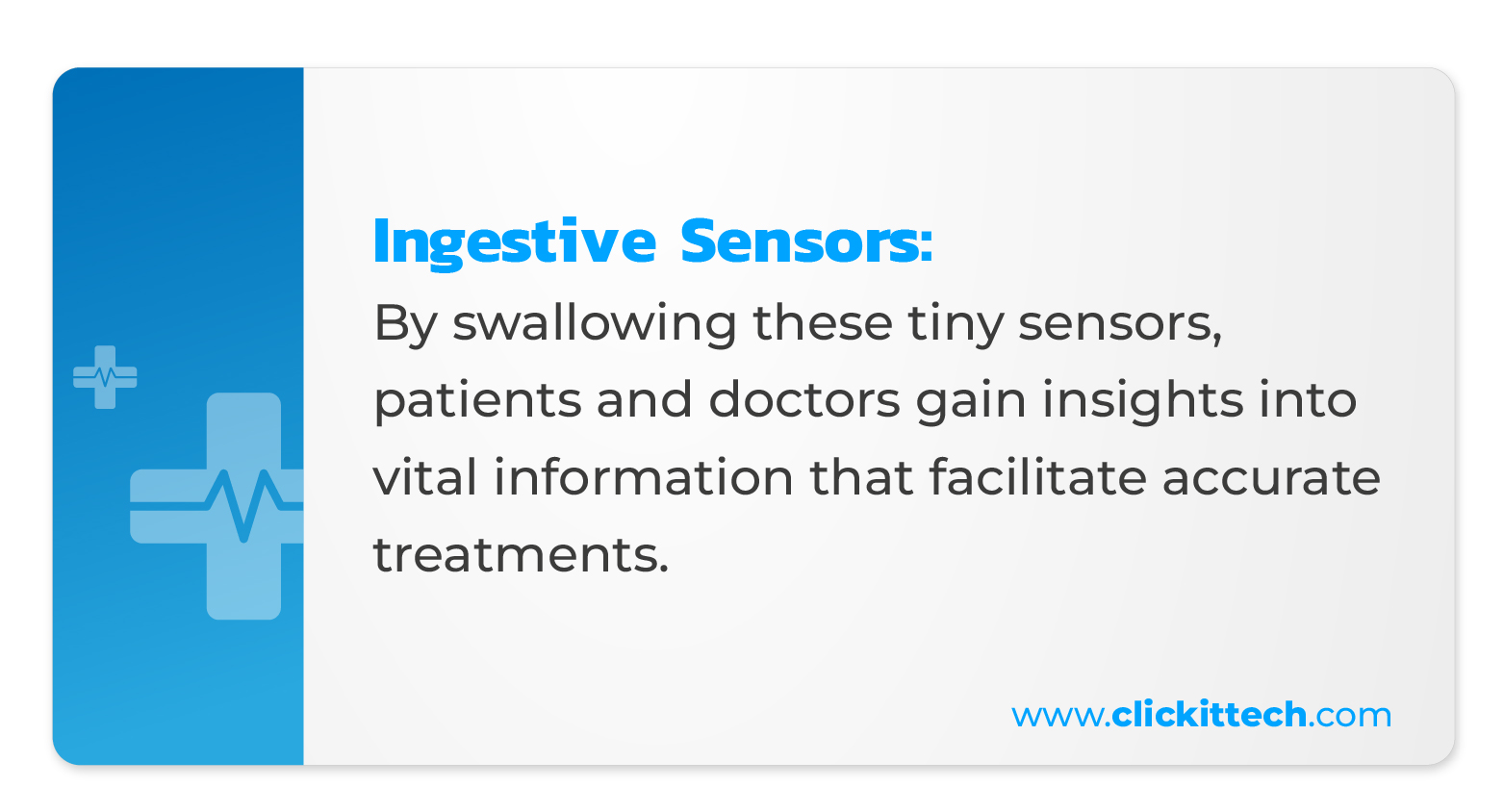
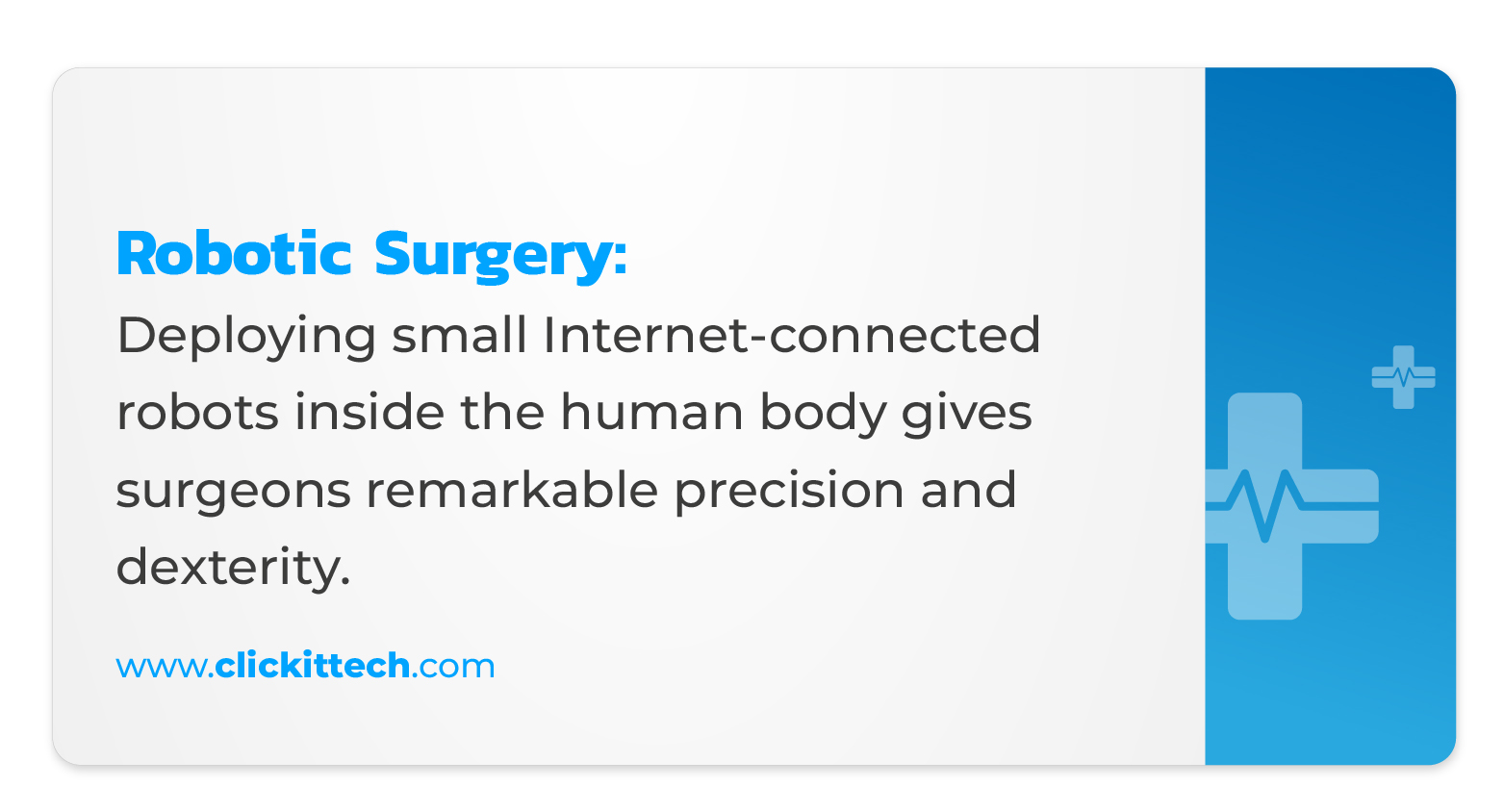
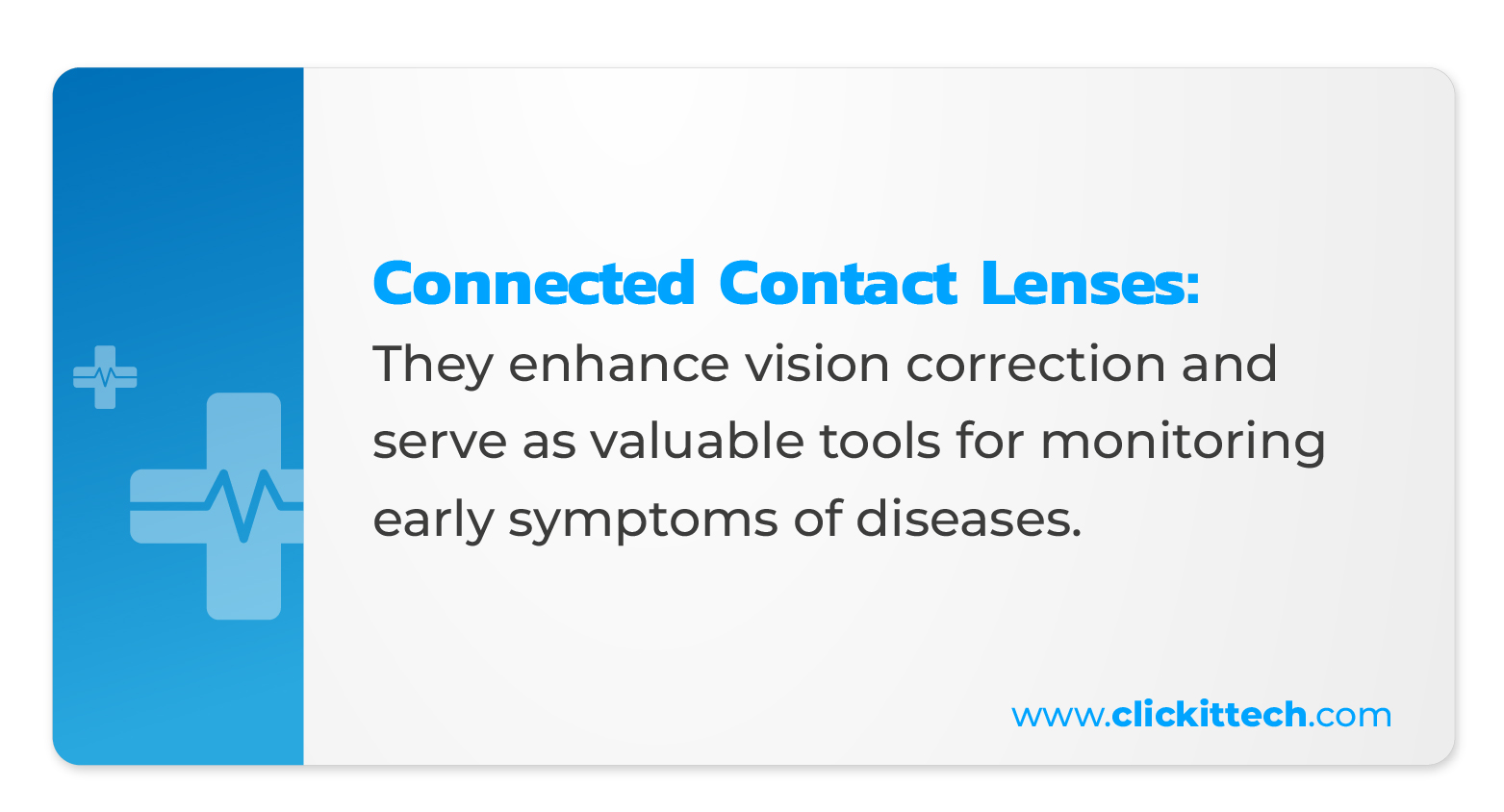
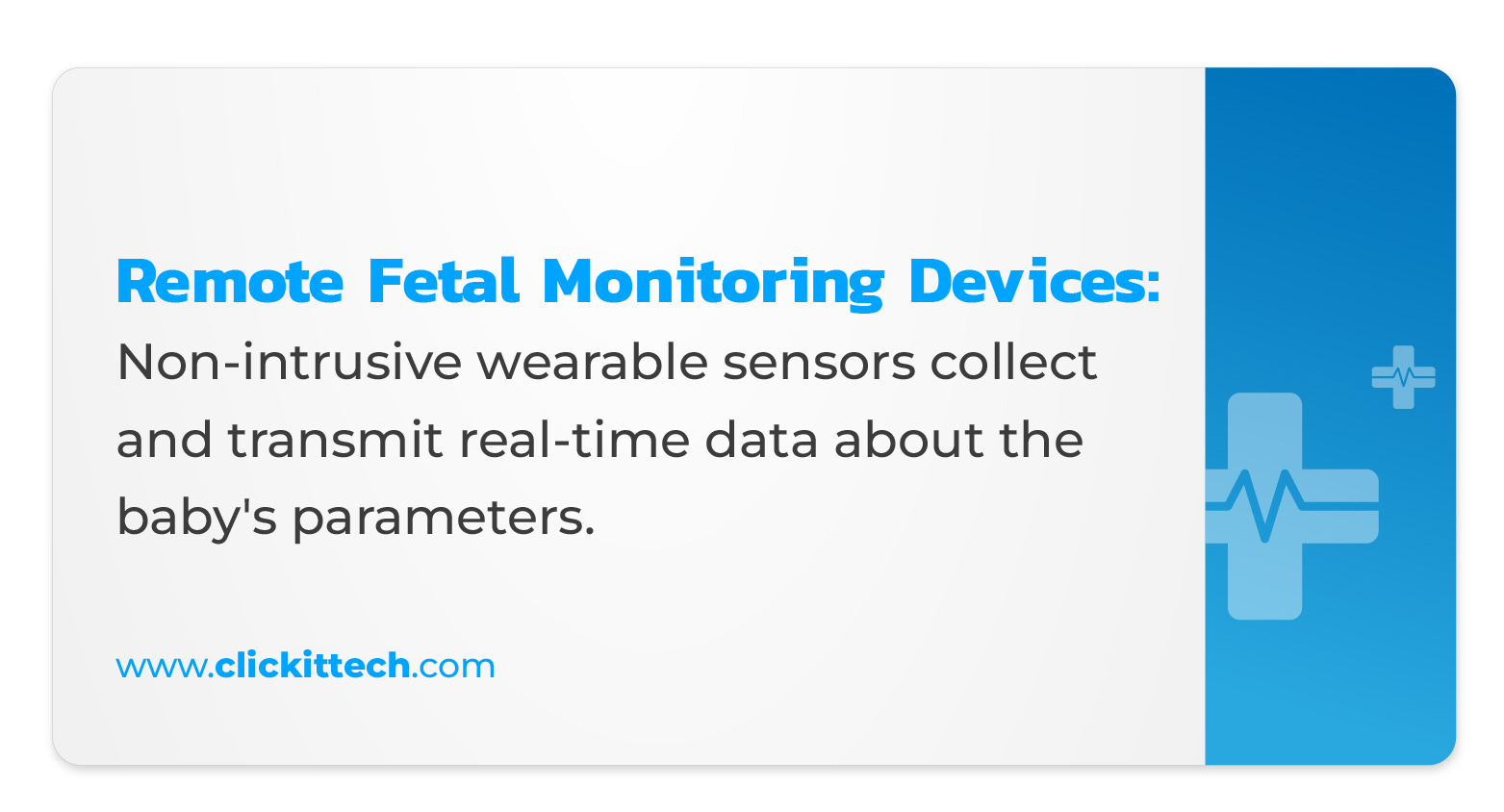
Remote Patient Monitoring
We have mentioned RPM a couple of times now, but to clear any doubt, they are devices that enable healthcare professionals to monitor and collect critical health metrics remotely.
Remote patient monitoring devices serve as vigilant healthcare companions, automatically collecting data from patients who may not be physically present in a healthcare facility. Thus, eliminating the need for individuals to make arduous trips to healthcare providers or self-collect information.
Upon collection, the patient data is securely transmitted to dedicated IoT software applications. Then, healthcare professionals and patients themselves can access and review the information.
Sophisticated algorithms come into play, analyzing the data to generate valuable insights and recommendations for treatments or alerts.
Consider, for example, an IoT sensor monitoring a patient’s heart rate. If an unusually low heart rate is detected, the system triggers an alert, notifying healthcare professionals promptly so they can intervene. This helps prevent complications and improves medical outcomes.
Popular RPM devices include Phillips eCare Coordinator and BIOTRONIK Home Monitoring.
Glucose Monitoring
Traditional manual glucose monitoring could only provide a snapshot of a patient’s current glucose level, leaving healthcare professionals in the dark about fluctuations over time. However, today, examples of IoT-powered glucose monitoring devices automate the process by continuously tracking and recording glucose levels. They create a comprehensive data record that can be accessed and analyzed anytime.
With real-time glucose data at their fingertips, individuals can make more informed decisions about their dietary choices, physical activities, and medication management.
Some examples of IoT healthcare glucose monitoring devices even offer automated insulin regulation. They provide constant glucose monitoring and also administer insulin doses as needed.
Dexcom Continuous Glucose Monitoring System and FreeStyle Libre Flash Glucose Monitoring System are examples of this type of device in the market.
Heart-Rate Monitoring
This type of IoT Healthcare application or device tracks a patient’s heart rate throughout the day and even during sleep.
One of the challenges of heart-rate monitoring lies in the dynamic nature of heart rate fluctuations. Heart rate is influenced by various activities and emotions throughout the day, making continuous monitoring necessary for accurate insights.
By capturing heart-rate data, these devices allow patients to continue their daily routines without interruption. Whether at work, exercising, or simply resting, patients can trust that their heart rate is being closely monitored.
If you’re interested in acquiring one of these devices, make sure to check out Polar H10 Heart Rate Monitor or Fitbit Charge 4 Fitness and Activity Tracker.
Parkinson’s Disease Monitoring
IoT Healthcare devices have emerged as valuable tools in treating patients with Parkinson’s disease.
Parkinson’s disease is a complex neurological disorder that requires careful monitoring of symptoms to deliver appropriate medical interventions. Traditionally, patients were confined to hospital facilities for extended periods to ensure accurate symptom tracking. However, with IoT Healthcare Devices, this process has drastically changed for the better.
Examples of IoT devices designed for Parkinson’s disease monitoring collect data on symptom patterns and variations in their severity. This way, healthcare professionals get significant insights for tailored treatment plans.
PDMonitor Solution is doing a great join of delivering this solution to Parkinson’s disease patients and aiding doctors’ labor.
Mood Trackers
To infer valuable information about a patient’s current mood and mental well-being, mood trackers utilize biometric data, such as heart rate, blood pressure, and eye movement.
In the past, assessing mood swings and emotional fluctuations relied on periodic patient inquiries, which might not accurately capture the true state of the patient’s mental health. Furthermore, subjective interpretations and potential inaccuracies in patient reporting further complicated the diagnostic process.
However, IoMT devices offer a transformative approach to mental health monitoring. After all, biometric indicators such as heart rate and blood pressure are not subject to conscious control. Meaning they give more accurate representations of a patient’s emotional well-being.
WHOOP and the already mentioned Fitbit are proven devices that can help you track your mood and its indicators.
Connected Inhalers
A key feature of connected inhalers is their ability to remind patients to take their medication promptly. These smart IoMT devices ensure patients never miss doses through periodic visual or audio alerts.
Moreover, with a connected application, valuable instructions on the correct usage of the inhaler are offered. Ensuring that patients receive the maximum benefits from their medication.
Additionally, connected inhalers play a crucial role in preventing medication misuse. They identify cases of overuse or improper usage, and the data collected is shared with healthcare professionals. Doctors can monitor patient progress remotely and intervene if misuse is detected.
Propeller Health and BreatheSuite are among the most in-demand brands of connected or smart inhalers.
Ingestive Sensors
Unlike traditional invasive procedures, these IoT-enabled sensors offer a far less intrusive approach to gathering information from internal systems.
By swallowing these tiny sensors, patients gain insights into the acidity of their digestive tract. This aids in the diagnosis and management of gastrointestinal conditions. Moreover, the sensors can be used to pinpoint the source of internal bleeding, providing vital information for medical professionals to facilitate accurate treatments.
However, the design of ingestive sensors presents unique challenges. They must be small enough to be easily swallowed without discomfort. Additionally, the sensors must be engineered to dissolve or pass through the human body naturally and cleanly. They should leave no adverse effects on the patient’s health.
The most advanced companies developing these devices include Olympus Corporation, CapsoVision, and Atmo Biosciences.
Robotic Surgery
Through robotic surgery, professionals perform complex procedures that would be challenging to manage using human hands alone.
Robotic surgery takes place by deploying small Internet-connected robots inside the human body. This gives surgeons remarkable precision and dexterity. Because of this, small robots can navigate delicate anatomical structures with greater finesse, leading to smaller incisions, reduced scarring, and faster patient healing times.
To execute successful robotic surgeries, IoMT devices must meet stringent requirements. They need to be small and agile enough to operate within the confined spaces of the human body without causing disruption or discomfort to the patient.
Additionally, these robots must possess robust interpretive abilities to comprehend complex conditions inside the body. Said characteristic allows them to make real-time decisions and adjustments during surgery.
Understanding collaborative robots or “cobots,” another revolutionary innovation in the field, can help in this context. These robots work hand in hand with doctors, offering precision, stability, and augmented capabilities that go beyond human limits.
Among the top surgery systems, you will find da Vinci by Intuitive Surgical, Mako by Stryker, and Ion by Intuitive Surgical.
Connected Contact Lenses
As examples IoT Healthcare solutions, connected contact lenses not only offer enhanced vision correction. They also serve as valuable tools for monitoring early symptoms of diseases.
Connected contact lenses, equipped with IoMT capabilities, can play a pivotal role in preventive healthcare. These smart lenses continuously monitor the wearer’s eyes, detecting subtle changes in eye health and providing information for early disease detection.
Withal, they also provide insights into broader medical conditions. For example, glucose levels in tears can indicate early signs of diabetes. Patients benefit from a more comprehensive health monitoring experience by incorporating such capabilities into contact lenses.
Sensimed Triggerfish and Mojo Vision Smart Contact Lens are great products for anyone interested in trying out connected contact lenses.
Remote Fetal Monitoring Devices
Fetal monitoring typically involves periodic visits to healthcare facilities, where specialized equipment assesses the baby’s heartbeat and other vital signs. However, this may not always provide a complete picture of fetal health between checkups, leaving parents with unanswered questions and concerns.
With remote fetal monitoring, expectant mothers can wear non-intrusive wearable sensors that collect and transmit real-time data about the baby’s parameters. Then, these data are securely sent to medical professionals, who can remotely monitor fetal health and identify potential irregularities or concerns.
Examples of these devices include Phillips’ Maternal and Fetal Monitoring Systems and Janitri Pregnancy Monitoring Solutions.
Check out the case study of our client, Ultrasound AI
Envisioning a Connected Future with IoT Healthcare
The IoT Healthcare solutions are already evident, transcending geographical barriers and time zones. Thus, physicians can now carry patient information wherever they go, making informed decisions and providing expert guidance even from afar.
As the world becomes increasingly connected, the global IoT Healthcare market is projected to soar to a staggering $187.60 billion by 2028. This is a testament to its potential to revolutionize the healthcare landscape.
In the future, the number of connected medical devices is expected to soar, driven by advancements in IoT technology and its integration into healthcare practices.
The IoMT devices of the future will be equipped with cutting-edge sensor technology, providing more accurate patient data than ever before. Artificial intelligence (AI) and machine learning algorithms will use this data to enable predictive healthcare and proactive interventions.
This wealth of IoMT-generated healthcare data will open up new frontiers in medical research and treatment options. Hence, with this information, healthcare professionals can gain deeper insights into diseases, identify patterns, and develop more effective therapies tailored to individual patients.
Partnering for Success: ClickIT is your Trusted Healthcare Development Partner
At ClickIT, we take pride in being at the forefront of this IoMT revolution, providing cutting-edge software development services to empower our clients with the best solutions.
Our team of skilled engineers and developers has a deep understanding of IoT Healthcare Device development’s unique challenges and opportunities. Subsequently, their expertise allows them to harness the power of the best tools and technologies in the industry. We create projects that not only meet but exceed our clients’ expectations.
ClickIT’s commitment to excellence is evident in our comprehensive IoT Healthcare software development approach. From concept to implementation, we meticulously plan and execute every aspect of our clients’ projects. Our team collaborates closely with customers, understanding their specific needs and providing tailored solutions that align perfectly with their vision.
With ClickIT as your trusted partner, you can rest assured that your IoT Healthcare development rests in the hands of experts dedicated to bringing your vision to life.
Conclusion of Internet of Things Healthcare
To close off, IoT Healthcare solutions has emerged as a transformative force in the world of medical technology. It is permanently revolutionizing the way we approach healthcare delivery and patient monitoring.
It’s more than clear that the true power of IoT applications in healthcare lies in its ability to extend healthcare beyond traditional boundaries.
Nonetheless, as the IoT Healthcare revolution continues to unfold, one thing is clear; the paradigm of healthcare is shifting towards an interconnected ecosystem where technology and compassion converge to create a healthier and more vibrant world.
The future of IoT is now, and it holds the promise of transformative IoT healthcare solutions for everyone involved.

IoT Healthcare FAQs
IoT Healthcare is an interconnected web of smart healthcare devices, sensors, and applications that monitor and improve patients’ healthcare. Moreover, these devices use chips, sensors, and other related technologies to collect and transmit relevant healthcare data.
There’s a vast list of benefits resulting from the implementation of IoT in healthcare. Nonetheless, the most popular ones involve cost control, increased accuracy in diagnosis and patient monitoring systems, logistics, and better patient experience.
Remote patient monitoring is among the most prominent examples of IoT (or IoMT) devices. Additionally, heart-rate and glucose monitoring, robotic surgery, mood trackers, and ingestive sensors are also quite popular uses of IoT examples.
IoT Healthcare providers can ensure data security and the privacy of their patients by implementing measures. Examples include: encryption, secure communication protocols, authentication devices, and access controls.



